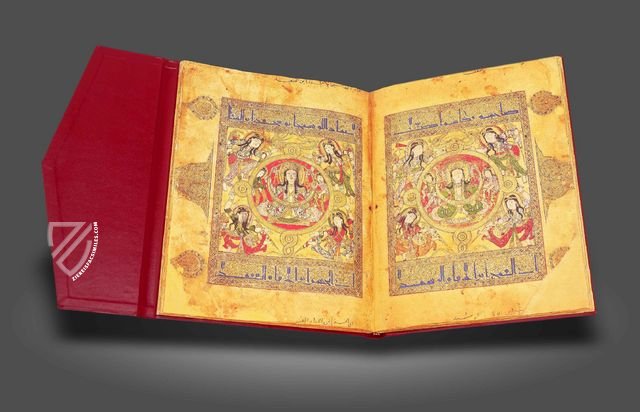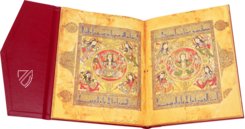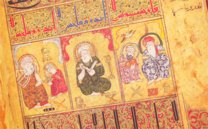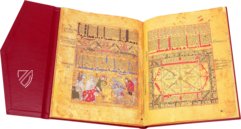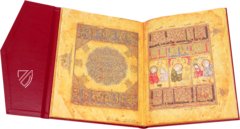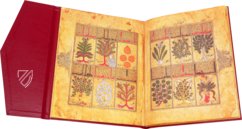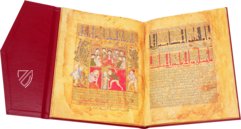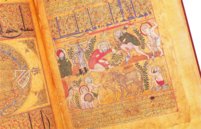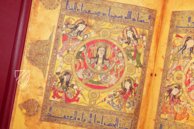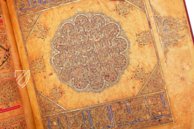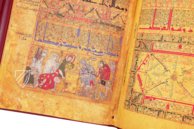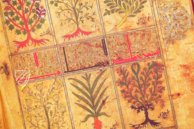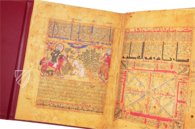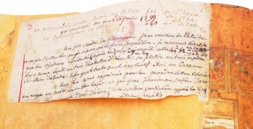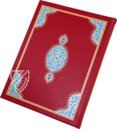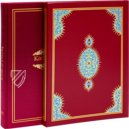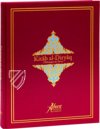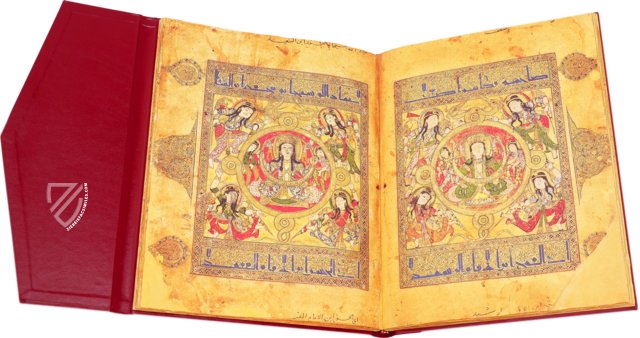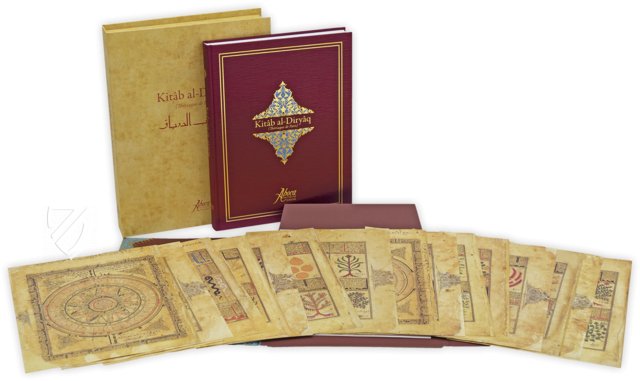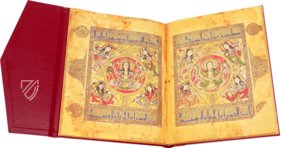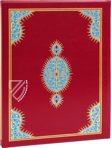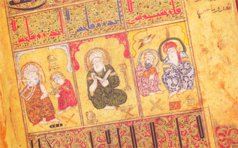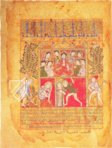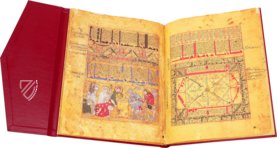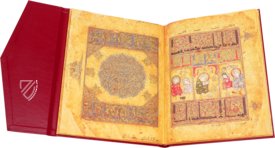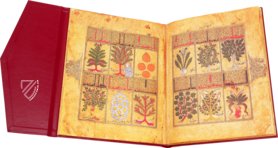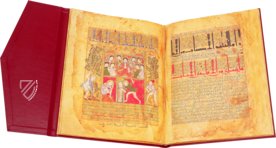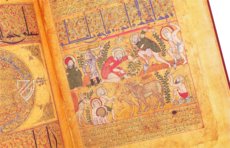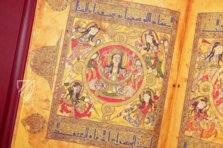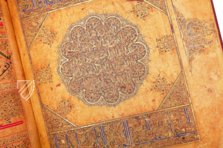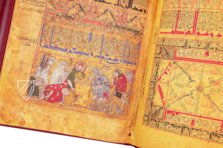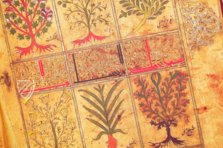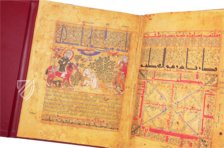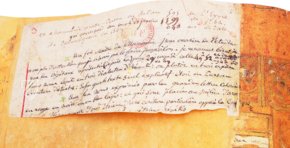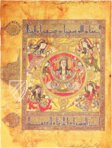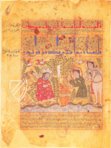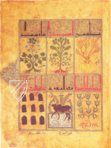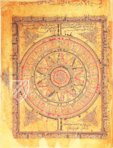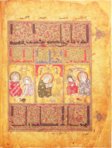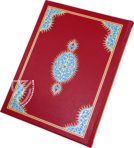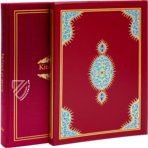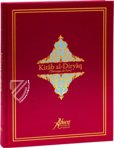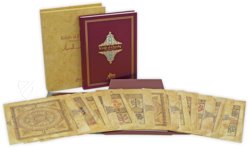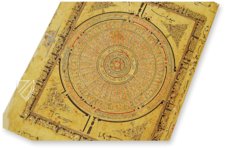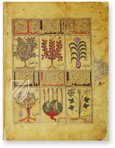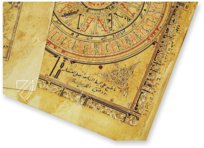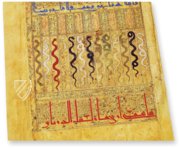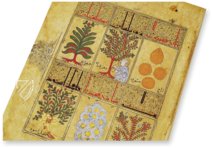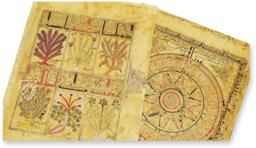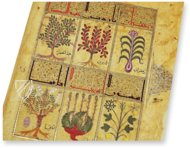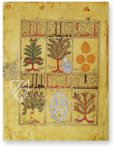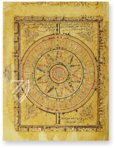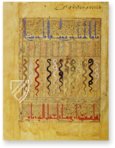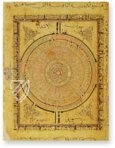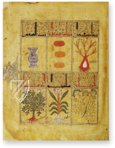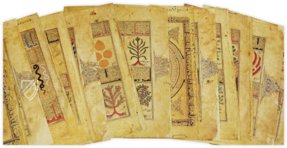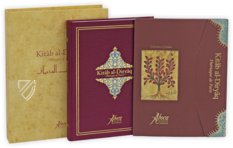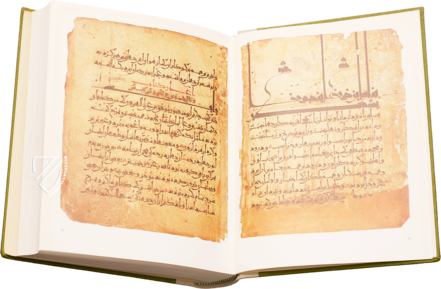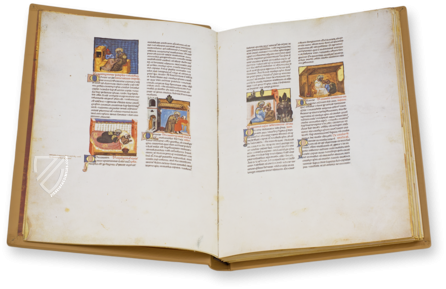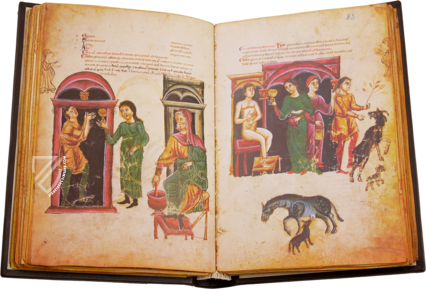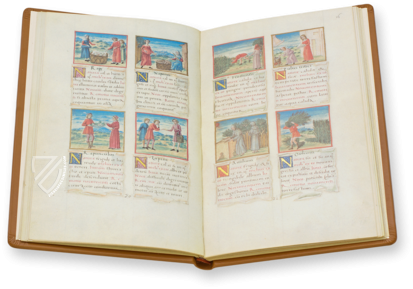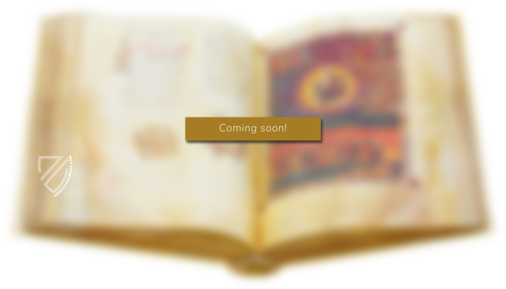Kitâb al-Diryâq (Thériaque de Paris)
(1,000€ - 3,000€)
A treatise on what is probably the most significant remedy of ancient and medieval medicine in one of the oldest illustrated Arabic manuscripts: the so-called Kitâb al-Diryâq, also known as the Thériaque de Paris. Originating in the Arab world towards the end of the 12th century, this valuable manuscript contains fascinating explanations on the production, application and effects of theriac, a universal remedy that is both widespread and shrouded in legend, consisting of diverse and mysterious recipes. These are presented to the reader in a setting of the most elaborate calligraphy, magnificent ornaments and costly gold jewelry, accompanied by numerous miniatures showing, among other things, Greek physicians and the required plants. The Kitâb al-Diryâq is therefore of great art-historical, medical-historical and botanical significance and presents itself as a true historical treasure!
Kitâb al-Diryâq (Thériaque de Paris)
Marvelous Arabic ornamentation overruns the pages of this manuscript and coalesces with the artful script into a true wonderwork of illumination. Half-page miniatures with realistic depictions of plants, people, and animals in interesting scenes appear continuously between them. All of that is immersed in bright colors and precious gold and exudes the mysterious charm of the Orient. Nonetheless, behind this famous Arabian manuscript, the so-called Thériaque de Paris, hides a significant work of art history: a treatise concerning theriac, which was the most important remedy for centuries.
The Panacea of Antiquity
Theriac has been known since antiquity and was a particularly wide-spread remedy in the Middle Ages, composed of various ingredients. Originally used against snake bites and bites from wild animals, theriac eventually evolved through the course of the Middle Ages into a widely circulated panacea. A wide variety of recipes developed over the centuries: the components of theriac ranged from herbs like fennel and caraway to spices (cardamom, pepper, or garlic), opium, and rare ingredients like viper meat and duck blood. Over time, more complicated recipes with hundreds of ingredients developed. The elaborate preparation at the center of the production of theriac became a major event, and was simultaneously a well-guarded secret.
A Precious Arab Manuscript
The manuscript with the shelf mark Ms. Arabe 2964 of the Bibliothèque nationale de France in Paris even contains these enigmatic recipes for theriac. Originating in the years 1198–1199 from the Arab world, the Kitâb al-Diryâq is considered to be one of the oldest illuminated Arab manuscripts. Muhammad ibn Abi al-Fath furnished his treatise on theriac with portraits of famous Greek physicians with their respective recipes for the preparation of theriac inter alia. Alongside those, one finds a gorgeous miniature with a scene depicting the preparation of the remedy inter alia: three men in a landscape, surrounded by leaves, among which birds frolic, a river with fish therein, and in the center stands a jug wherein the theriac is mixed.
A Gem of the History of Art and Culture
The Kitâb al-Diryâq presents text and picture in complete harmony. The oriental manuscript is both culturally important as well as of great worth for the history of science and botany. It presumably originated from the commission of a high-ranking person, as is indicated by the abundant wealth of its artistic furnishings. The Thériaque de Paris is a unique work of illumination and is a true treasure for researchers into the fascinating history of theriac.
Codicology
- Alternative Titles
- Paris Theriaka
Theriaque de Paris
Livre de la Thériaque de Paris
Paris Kitâb al- Diryâq - Size / Format
- 73 pages / 37 × 28.5 cm
- Origin
- Iran
- Date
- 1198
- Epochs
- Style
- Language
- Illustrations
- 8 half-page miniatures, 12 miniature pages each containing 6 registers with depictions of plants, 9 smaller portraits of scholars, opulent ornamentation and elaborate calligraphy
- Content
- Treatise on the preparation, use and medicinal effect of the drug Theriak
- Artist / School
- Muhammad ibn Abi al-Fath (author)
Kitâb al-Diryâq (Thériaque de Paris)
Extracting Oil from a Balsam Tree
The only botanical page in the manuscript to feature a human figure shows a man kneeling before a balsam tree as he extracts oil from it with a long, thin tube in the central gold-framed compartment of the upper register. Like the other figures in the manuscript, he is depicted with a halo, which is likely a residual influence from Byzantine illumination. The other ingredients depicted with their names written in red and black ink include vitriol, gentian, valerian, malabathrum, and black pepper.
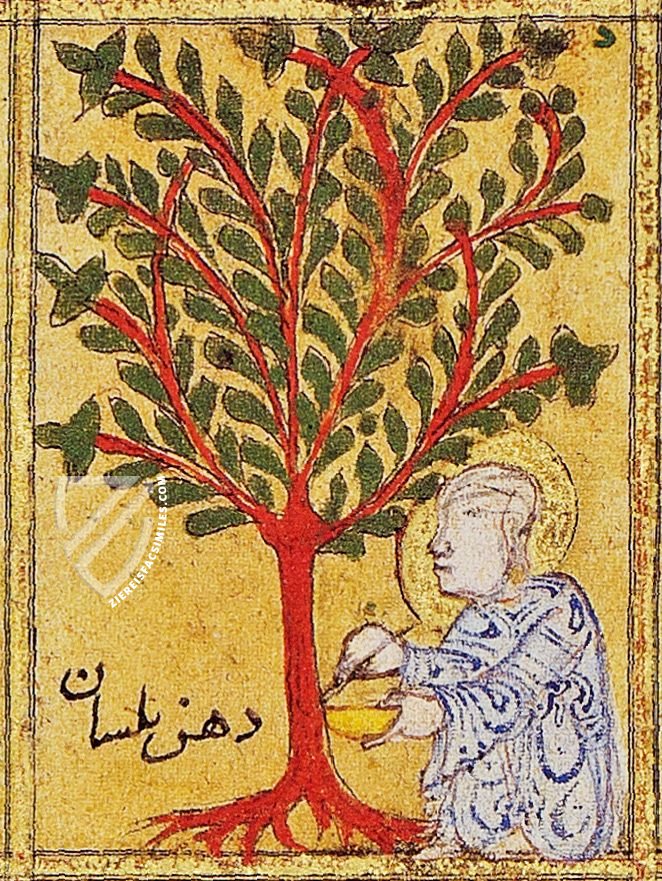
Kitâb al-Diryâq (Thériaque de Paris)
The 96 “Simple” Ingredients of Theriac
Theriac was supposedly first invented by King Mithridates VI of Pontus who experimented with poisons and antidotes on his prisoners. After he was defeated and his kingdom conquered, his recipe fell into the hands of the Romans. Andromachus the Younger, personal physician to the Emperor Nero, refined the recipe, which included opium, myrrh, saffron, ginger, cinnamon, castor, and viper’s flesh.
The page sparkles with gold leaf and is designed like a rug with a star in the center surrounded by a circle, which has the ingredients’ name written alternately in black and red ink. An unusual inscription in the rectangular frame praises the ancient, pagan physician and Islamizes him by bestowing the protection of Allah upon him.
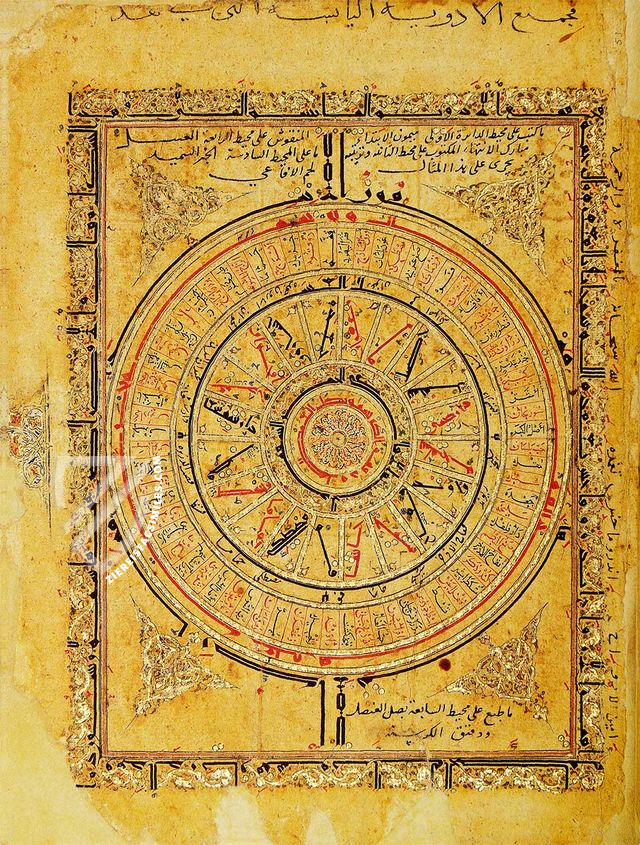
#1 Kitâb al-Diryâq (Thériaque de Paris)
Languages: Arabic, English, French , German, Italian, Spanish
(1,000€ - 3,000€)
#2 Kitâb al-Diryâq (Set of 15 plates)
Languages: Arabic, English, French , German, Italian, Spanish
(under 1,000€)
- Treatises / Secular Books
- Apocalypses / Beatus
- Astronomy / Astrology
- Bestiaries
- Bibles / Gospels
- Chronicles / History / Law
- Geography / Maps
- Saints' Lives
- Islam / Oriental
- Judaism / Hebrew
- Single Leaf Collections
- Leonardo da Vinci
- Literature / Poetry
- Liturgical Manuscripts
- Medicine / Botany / Alchemy
- Music
- Mythology / Prophecies
- Psalters
- Other Religious Books
- Games / Hunting
- Private Devotion Books
- Other Genres
- Afghanistan
- Armenia
- Austria
- Belgium
- Belize
- Bosnia and Herzegovina
- China
- Colombia
- Costa Rica
- Croatia
- Cyprus
- Czech Republic
- Denmark
- Egypt
- El Salvador
- Ethiopia
- France
- Germany
- Greece
- Guatemala
- Honduras
- Hungary
- India
- Iran
- Iraq
- Israel
- Italy
- Japan
- Jordan
- Kazakhstan
- Kyrgyzstan
- Lebanon
- Liechtenstein
- Luxembourg
- Mexico
- Morocco
- Netherlands
- Palestine
- Panama
- Peru
- Poland
- Portugal
- Romania
- Russia
- Serbia
- Spain
- Sri Lanka
- Sweden
- Switzerland
- Syria
- Tajikistan
- Turkey
- Turkmenistan
- Ukraine
- United Kingdom
- United States
- Uzbekistan
- Vatican City
- A. Oosthoek, van Holkema & Warendorf
- Aboca Museum
- Ajuntament de Valencia
- Akademie Verlag
- Akademische Druck- u. Verlagsanstalt (ADEVA)
- Aldo Ausilio Editore - Bottega d’Erasmo
- Alecto Historical Editions
- Alkuin Verlag
- Almqvist & Wiksell
- Amilcare Pizzi
- Andreas & Andreas Verlagsbuchhandlung
- Archa 90
- Archiv Verlag
- Archivi Edizioni
- Arnold Verlag
- ARS
- Ars Magna
- ArtCodex
- AyN Ediciones
- Azimuth Editions
- Badenia Verlag
- Bärenreiter-Verlag
- Belser Verlag
- Belser Verlag / WK Wertkontor
- Benziger Verlag
- Bernardinum Wydawnictwo
- BiblioGemma
- Biblioteca Apostolica Vaticana (Vaticanstadt, Vaticanstadt)
- Bibliotheca Palatina Faksimile Verlag
- Bibliotheca Rara
- Boydell & Brewer
- Bramante Edizioni
- Bredius Genootschap
- Brepols Publishers
- British Library
- C. Weckesser
- Caixa Catalunya
- Canesi
- CAPSA, Ars Scriptoria
- Caratzas Brothers, Publishers
- Carus Verlag
- Casamassima Libri
- Centrum Cartographie Verlag GmbH
- Chavane Verlag
- Christian Brandstätter Verlag
- Circulo Cientifico
- Club Bibliófilo Versol
- Club du Livre
- CM Editores
- Collegium Graphicum
- Collezione Apocrifa Da Vinci
- Comissão Nacional para as Comemorações dos Descobrimentos Portugueses
- Coron Verlag
- Corvina
- CTHS
- D. S. Brewer
- Damon
- De Agostini/UTET
- De Nederlandsche Boekhandel
- De Schutter
- Deuschle & Stemmle
- Deutscher Verlag für Kunstwissenschaft
- DIAMM
- Droz
- E. Schreiber Graphische Kunstanstalten
- Ediciones Boreal
- Ediciones Grial
- Ediclube
- Edições Inapa
- Edilan
- Editalia
- Edition Deuschle
- Edition Georg Popp
- Edition Leipzig
- Edition Libri Illustri
- Editiones Reales Sitios S. L.
- Éditions de l'Oiseau Lyre
- Editions Medicina Rara
- Editorial Casariego
- Editorial Mintzoa
- Editrice Antenore
- Editrice Velar
- Edizioni Edison
- Egeria, S.L.
- Eikon Editores
- Electa
- Emery Walker Limited
- Enciclopèdia Catalana
- Eos-Verlag
- Ephesus Publishing
- Ernst Battenberg
- Eugrammia Press
- Extraordinary Editions
- Fackelverlag
- Facsimila Art & Edition
- Facsimile Editions Ltd.
- Facsimilia Art & Edition Ebert KG
- Faksimile Verlag
- Feuermann Verlag
- Folger Shakespeare Library
- Franco Cosimo Panini Editore
- Friedrich Wittig Verlag
- Fundación Hullera Vasco-Leonesa
- G. Braziller
- Gabriele Mazzotta Editore
- Gebr. Mann Verlag
- Gesellschaft für graphische Industrie
- Getty Research Institute
- Giovanni Domenico de Rossi
- Giunti Editore
- Graffiti
- Grafica European Center of Fine Arts
- Guido Pressler
- Guillermo Blazquez
- Gustav Kiepenheuer
- H. N. Abrams
- Harrassowitz
- Harvard University Press
- Helikon
- Hendrickson Publishers
- Henning Oppermann
- Herder Verlag
- Hes & De Graaf Publishers
- Hoepli
- Holbein-Verlag
- Houghton Library
- Hugo Schmidt Verlag
- Idion Verlag
- Il Bulino, edizioni d'arte
- ILte
- Imago
- Insel Verlag
- Insel-Verlag Anton Kippenberger
- Instituto de Estudios Altoaragoneses
- Instituto Nacional de Antropología e Historia
- Introligatornia Budnik Jerzy
- Istituto dell'Enciclopedia Italiana - Treccani
- Istituto Ellenico di Studi Bizantini e Postbizantini
- Istituto Geografico De Agostini
- Istituto Poligrafico e Zecca dello Stato
- Italarte Art Establishments
- Jan Thorbecke Verlag
- Johnson Reprint Corporation
- Josef Stocker
- Josef Stocker-Schmid
- Jugoslavija
- Karl W. Hiersemann
- Kasper Straube
- Kaydeda Ediciones
- Kindler Verlag / Coron Verlag
- Kodansha International Ltd.
- Konrad Kölbl Verlag
- Kurt Wolff Verlag
- La Liberia dello Stato
- La Linea Editrice
- La Meta Editore
- Lambert Schneider
- Landeskreditbank Baden-Württemberg
- Leo S. Olschki
- Les Incunables
- Liber Artis
- Library of Congress
- Libreria Musicale Italiana
- Lichtdruck
- Lito Immagine Editore
- Lumen Artis
- Lund Humphries
- M. Moleiro Editor
- Maison des Sciences de l'homme et de la société de Poitiers
- Manuscriptum
- Martinus Nijhoff
- Maruzen-Yushodo Co. Ltd.
- MASA
- Massada Publishers
- McGraw-Hill
- Metropolitan Museum of Art
- Militos
- Millennium Liber
- Müller & Schindler
- Nahar - Stavit
- Nahar and Steimatzky
- National Library of Wales
- Neri Pozza
- Nova Charta
- Oceanum Verlag
- Odeon
- Orbis Mediaevalis
- Orbis Pictus
- Österreichische Staatsdruckerei
- Oxford University Press
- Pageant Books
- Parzellers Buchverlag
- Patrimonio Ediciones
- Pattloch Verlag
- PIAF
- Pieper Verlag
- Plon-Nourrit et cie
- Poligrafiche Bolis
- Presses Universitaires de Strasbourg
- Prestel Verlag
- Princeton University Press
- Prisma Verlag
- Priuli & Verlucca, editori
- Pro Sport Verlag
- Propyläen Verlag
- Pytheas Books
- Quaternio Verlag Luzern
- Reales Sitios
- Recht-Verlag
- Reichert Verlag
- Reichsdruckerei
- Reprint Verlag
- Riehn & Reusch
- Roberto Vattori Editore
- Rosenkilde and Bagger
- Roxburghe Club
- Salerno Editrice
- Saltellus Press
- Sandoz
- Sarajevo Svjetlost
- Schöck ArtPrint Kft.
- Schulsinger Brothers
- Scolar Press
- Scrinium
- Scripta Maneant
- Scriptorium
- Shazar
- Siloé, arte y bibliofilia
- SISMEL - Edizioni del Galluzzo
- Sociedad Mexicana de Antropología
- Société des Bibliophiles & Iconophiles de Belgique
- Soncin Publishing
- Sorli Ediciones
- Stainer and Bell
- Studer
- Styria Verlag
- Sumptibus Pragopress
- Szegedi Tudomànyegyetem
- Taberna Libraria
- Tarshish Books
- Taschen
- Tempus Libri
- Testimonio Compañía Editorial
- Thames and Hudson
- The Clear Vue Publishing Partnership Limited
- The Facsimile Codex
- The Folio Society
- The Marquess of Normanby
- The Richard III and Yorkist History Trust
- Tip.Le.Co
- TouchArt
- TREC Publishing House
- TRI Publishing Co.
- Trident Editore
- Tuliba Collection
- Typis Regiae Officinae Polygraphicae
- Union Verlag Berlin
- Universidad de Granada
- University of California Press
- University of Chicago Press
- Urs Graf
- Vallecchi
- Van Wijnen
- VCH, Acta Humaniora
- VDI Verlag
- VEB Deutscher Verlag für Musik
- Verlag Anton Pustet / Andreas Verlag
- Verlag Bibliophile Drucke Josef Stocker
- Verlag der Münchner Drucke
- Verlag für Regionalgeschichte
- Verlag Styria
- Vicent Garcia Editores
- W. Turnowski Ltd.
- W. Turnowsky
- Waanders Printers
- Wiener Mechitharisten-Congregation (Wien, Österreich)
- Wissenschaftliche Buchgesellschaft
- Wissenschaftliche Verlagsgesellschaft
- Wydawnictwo Dolnoslaskie
- Xuntanza Editorial
- Zakład Narodowy
- Zollikofer AG

